vs2019 .net core 3.1 使用GRPC 多个proto文件
服务端:
1.使用vs2019创建GRPC服务端
2.在项目下的Protos文件夹创建.proto文件
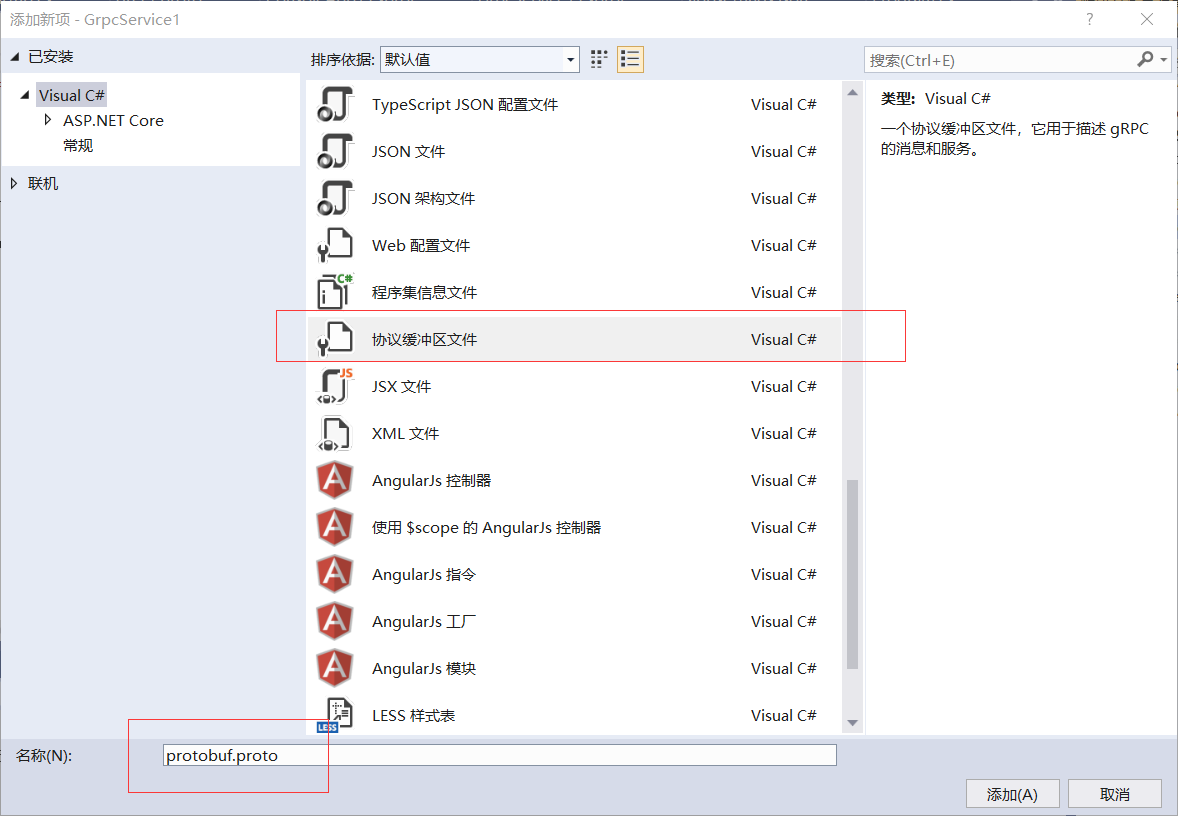
内容设置如下:
syntax = "proto3"; // 命名空间 option csharp_namespace = "GrpcService1"; package first; //定义的服务 service ProFirst { // 方法 rpc SayHello (LxpRequest) returns (LxpReply); // 方法 rpc GetUserInfo(LxpRequest) returns(LxpReply); } //请求体 message LxpRequest { string name = 1; string age = 4; } //响应体 message LxpReply { string message = 1; }
3.右键项目->编辑项目文件->将创建的.proto文件添加进去,vs2019自动生成代码
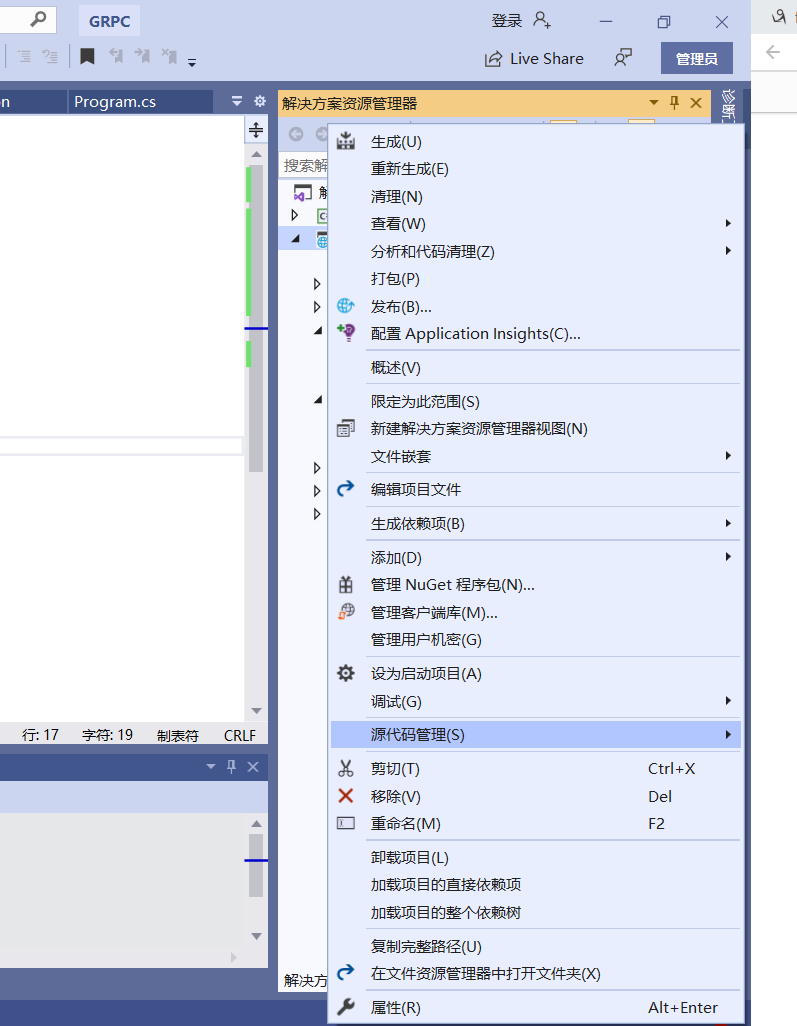
<Project Sdk="Microsoft.NET.Sdk.Web">
<PropertyGroup>
<TargetFramework>netcoreapp3.1</TargetFramework>
</PropertyGroup>
<ItemGroup>
<!--此处为proto文件的路径,编辑器会去查找对应的proto文件并生成代码-->
<!--注意此处的 GrpcServices 属性需要设置为Server,如果是客户端的话需要设置为Client-->
<Protobuf Include="Protos\greet.proto" GrpcServices="Server" />
<Protobuf Include="Protos\first.proto" GrpcServices="Server" />
</ItemGroup>
<ItemGroup>
<PackageReference Include="Grpc.AspNetCore" Version="2.27.0" />
</ItemGroup>
</Project>
设置完成会在项目的obj>debug>netcoreapp3.1目录下自动生成对应的代码
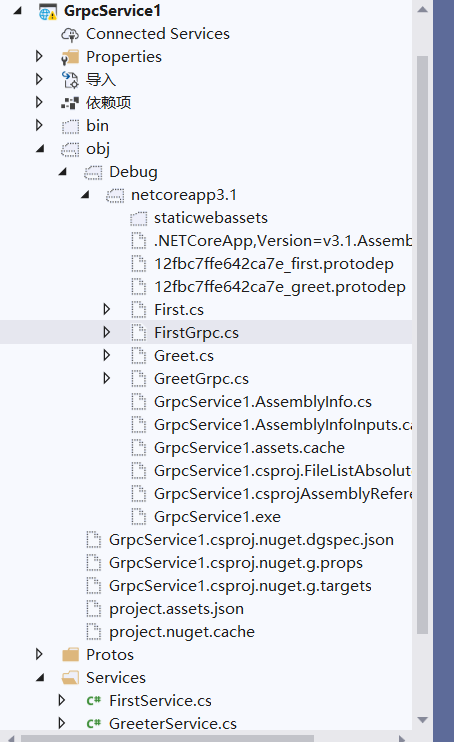
3.在项目下的Services文件
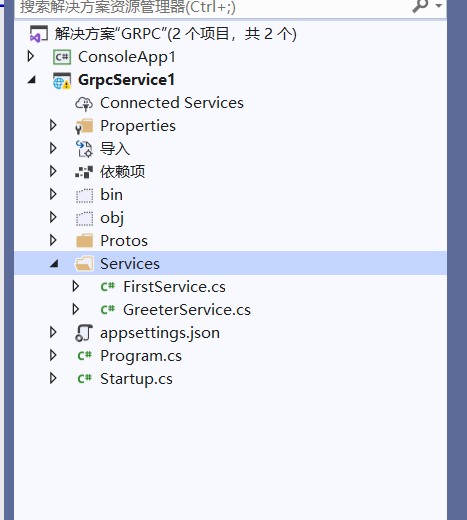
在Service文件夹添加类,让该类继承proto自动生成的代码,并且重写,这里需要注意的是 每次在proto文件新增方法的时候需要在该文件实现,否则会调用错误,报未实现的错误
using Grpc.Core; using Microsoft.Extensions.Logging; using System; using System.Collections.Generic; using System.Linq; using System.Reflection.Metadata.Ecma335; using System.Threading.Tasks; namespace GrpcService1 { // 这里继承proto文件生成的服务抽象类,需要自己实现 public class FirstService : ProFirst.ProFirstBase { private readonly ILogger<FirstService> _logger; public FirstService(ILogger<FirstService> logger) { _logger = logger; } public override bool Equals(object obj) { return base.Equals(obj); } public override int GetHashCode() { return base.GetHashCode(); } public override Task<LxpReply> GetUserInfo(LxpRequest request, ServerCallContext context) { return Task.FromResult(new LxpReply { Message = "LXP 我爱你" }); } public override Task<LxpReply> SayHello(LxpRequest request, ServerCallContext context) { return Task.FromResult(new LxpReply { Message = "LXP 你好" }); } public override string ToString() { return base.ToString(); } } }
4.在startup类文件配置grpc
startup文件中需要启用,在ConfigureServices注册服务,Configure设置服务的终结点
using System; using System.Collections.Generic; using System.Linq; using System.Threading.Tasks; using Microsoft.AspNetCore.Builder; using Microsoft.AspNetCore.Hosting; using Microsoft.AspNetCore.Http; using Microsoft.Extensions.DependencyInjection; using Microsoft.Extensions.Hosting; namespace GrpcService1 { public class Startup { // This method gets called by the runtime. Use this method to add services to the container. // For more information on how to configure your application, visit https://go.microsoft.com/fwlink/?LinkID=398940 public void ConfigureServices(IServiceCollection services) { services.AddGrpc(); } // This method gets called by the runtime. Use this method to configure the HTTP request pipeline. public void Configure(IApplicationBuilder app, IWebHostEnvironment env) { if (env.IsDevelopment()) { app.UseDeveloperExceptionPage(); } app.UseRouting(); app.UseEndpoints(endpoints => { endpoints.MapGrpcService<GreeterService>(); endpoints.MapGrpcService<FirstService>();//自己新加的服务类 endpoints.MapGet("/", async context => { await context.Response.WriteAsync("Communication with gRPC endpoints must be made through a gRPC client. To learn how to create a client, visit: https://go.microsoft.com/fwlink/?linkid=2086909"); }); }); } } }
5.在appsettings.json文件配置http2
{ "Logging": { "LogLevel": { "Default": "Information", "Microsoft": "Warning", "Microsoft.Hosting.Lifetime": "Information" } }, "AllowedHosts": "*", "Kestrel": { "EndpointDefaults": { "Protocols": "Http2" } } }
然后在测试的时候需要使用临时的证书,点击确定,如果需要发布到正式环境下需要申请证书
点击运行
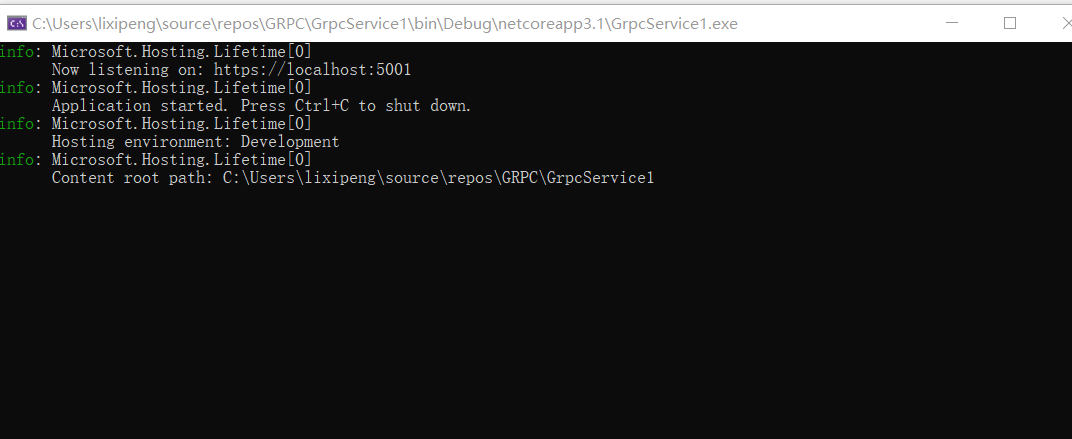
客户端(控制台或asp.net mvc等等):
1.安装nuget包 grpc-aspnetcore

2.将服务端的Protos文件夹整个复制到客户端
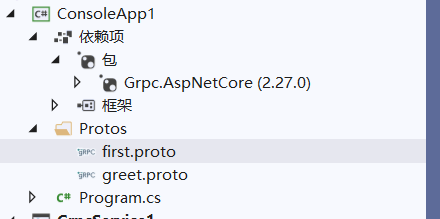
3.右键项目->编辑项目文件->将创建的.proto文件添加进去,将Server修改为Client,vs2019自动生成代码
<Project Sdk="Microsoft.NET.Sdk"> <PropertyGroup> <OutputType>Exe</OutputType> <TargetFramework>netcoreapp3.1</TargetFramework> </PropertyGroup> <ItemGroup> <None Remove="Protos\first.proto" /> </ItemGroup> <ItemGroup> <PackageReference Include="Grpc.AspNetCore" Version="2.27.0" /> </ItemGroup> <ItemGroup> <!--这里需要注意GrpcServices修改为Client--> <Protobuf Include="Protos\first.proto" GrpcServices="Client" /> <Protobuf Include="Protos\greet.proto" GrpcServices="Client" /> </ItemGroup> </Project>
4.开始愉快的使用,在项目需要的地方调用
using Grpc.Core; using Grpc.Net.Client; using GrpcService1; using System; namespace ConsoleApp1 { class Program { static async System.Threading.Tasks.Task Main(string[] args) { var channel = GrpcChannel.ForAddress("https://localhost:5001"); var client = new Greeter.GreeterClient(channel); var sayHello = client.SayHello(new HelloRequest { Name = "123" }); var sayHelloAsync = await client.SayHelloAsync(new HelloRequest { Name = "123" }); var client1 = new ProFirst.ProFirstClient(channel); var client1SayHello = client1.SayHello(new LxpRequest { Name = "123", Age = "123" }); var userInfo = client1.GetUserInfo(new LxpRequest { Name = "321", Age = "abc" }); var userInfoAsync = await client1.GetUserInfoAsync(new LxpRequest { Name = "321", Age = "abc" }); Console.WriteLine("Hello World!"); } } }



